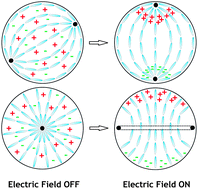Influence of surface anchoring conditions on the dielectric and electro-optical properties of nematic droplets dispersed in a polymer network
Abstract
Dielectric and electro-optical properties of liquid crystal (LC) dispersions exhibiting two different surface anchoring conditions at the polymer–LC interface are investigated. The confining surface was tuned by changing the side chains of the polymeric matrix in order to get either planar or homeotropic anchoring conditions and, in turn, bipolar or radial LC droplets, respectively. In the low frequency region of the dielectric spectra, LC dispersions exhibit a broad absorption domain, which has been assigned to a depolarization field effect (Maxwell–Wagner–Sillars (MWS) mechanism). The strength and relaxation frequency of the MWS process are closely related to the geometry of the confined LC phase. In the case of radial droplets, the electrical conductivity dominates whereas for bipolar droplets capacitive effects are predominant. From electro-optical (EO) measurements and numerical simulations of the electric field inside droplets, it is shown that bipolar droplets exhibit enhanced EO performances compared to their radial counterparts. Based on simple topological and electrodynamic approaches, this phenomenon is related to the spatial distribution of charges inside droplets.


 Please wait while we load your content...
Please wait while we load your content...